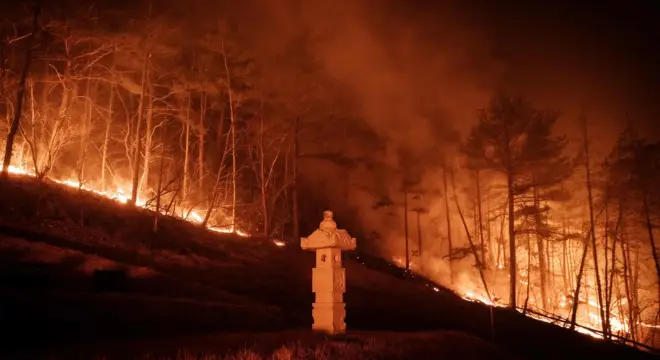What happens when a crucial government data center catches fire and wipes out hundreds of terabytes of information? How should leaders balance public visibility with crisis management during a national emergency? And what are the consequences when both technology and human lives are put to the test simultaneously?
A few weeks ago, South Korea was facing one of the most unusual crises in recent history after the fire at a National Information Resources Service (NIRS) data center in Daejeon on September 26, 2025; this incident interrupted hundreds of government online services and led to national debate. The event raised not only the technical vulnerabilities of government systems, but the political implications of visible leadership during emergencies.
Let’s examine the South Korea in crisis NIRS Fire case.
The Fire and Data Center Destruction
The NIRS facility, a key hub for South Korea’s government cloud infrastructure, experienced a battery fire in its server room on the fifth floor. The blaze destroyed 96 critical information systems, including the G-Drive platform, used by approximately 750,000 civil servants for storing official work files. G-Drive, a government-only cloud storage system, offered 30GB of space per employee and has been operational since 2018.
Due to its large-capacity, low-performance storage structure, G-Drive did not maintain external backups, resulting in the permanent loss of an estimated 858TB of government data. While other systems had backup mechanisms either onsite or remotely, the vulnerability of G-Drive left the government’s digital operations severely compromised.
The Ministry of the Interior and Safety noted that while some data may be recoverable through the Onnara system and locally stored files on personal computers, full restoration of all affected services is expected to take up to a month. Only 115 of 647 networks were restored as of early October, highlighting the scale of disruption.
Human Tragedy Amid the Crisis
The consequences of the fire extended beyond damage to equipment and technology. A senior official in the government and part of the Digital Government Innovation Office, which is responsible for overseeing the restoration of NIRS, died by suicide on October 3. News outlets report he was 56 years old, and authorities are looking into the possibility that he was overworked and stressed.
Four others have also been arrested as part of the investigation, to determine if professional negligence played a factor in the fire.
Political Controversy: President Lee’s Variety Show Appearance
During this time of national tragedy, President Lee Jae Myung and First Lady Kim Hye-kyung took to the air for a special Chuseok variety show on JTBC now called “Please Care of My Refrigerator“, which incited public discussion and criticism. The show features chefs analyzing the contents of the domestic refrigerators of guests in order to prepare meals, with the documentation of the presidential couple being their opportunity to promote K-food.
President Lee stated, “K-pop and K-drama are important, but food is the base of culture,” and First Lady Kim added they were hoping to provide some K-food dishes that could invite foreigners to the dining table in Korea. This Chuseok special was recorded on September 28, before the first round of emergency meetings regarding the initial state of emergency but after the team and staff had met, prior to the airing which was delayed for public viewing on Monday at 10pm. The show was postponed due to the disaster.
Opposition Criticism and Ruling Party Defense
The People Power Party (PPP) and other critics claim it was inappropriate for the president to appear during a national emergency, particularly in light of the government official’s death. Jang Donghyuk, the leader of the PPP, wrote on social media, “Rather than the content of the President’s refrigerator, I’m more curious what is in the mind of the President.”
PPP lawmaker Joo Jinwoo questioned, “Is it appropriate for the President and First Lady to appear on a variety show and laugh in a crisis when the NIRS fire announcement is at the highest alert level?“
The Democratic Party defended President Lee, calling the accusations’ smear and claiming that budget cuts during the previous Yoon Suk-yeol administration were also to blame, which raised questions about the opposition’s politically motivated attacks.

Cultural Context: Why the Show?
The official teaser published by JTBC clarified the reason for the appearance, noting that President Lee and the First Lady wanted to spotlight K- food as a core component of Korean culture. The show’s producers observed that the appearance had been slated to happen prior to the fire, as well as the presidential office’s position that President Lee had led emergency response meetings before and after the filming, and was in fact performing his official duties.
Lessons Learned: Technology, Governance, and Leadership
The NIRS fire has raised multiple urgent questions for the ROK:
- Government Data Management: The permanent loss of 858TB of data is a grim reminder of the flaws present in the backup and redundancy policies in government IT infrastructure, almost none of which are able to guarantee redundancy for anything approaching this volume of data.
- Workplace Safety and Mental Health: The tragic death of the official is a reminder of the human cost of “sharing the crisis” and the pressures on our civil servants.
- Leadership and Public Image: President Lee’s public appearance on a talk show has raised questions as to whether you can balance public relations, cultural promotion, and responsibility for a crisis.
- Political Accountability: Both political party’s state media are weaponizing this incident to criticize or support the administrator’s defense of an advanced policy, showing the political consequences of poor technological infrastructure.
Conclusion
The NIRS fire in Daejeon is a multi-dimensional crisis affecting technology and human life broadly, and politically. As South Korea processes to restore service and recuperate lost services, this event will serve as a wake-up call to all governments about the need for strong digital infrastructure, trustworthy leadership, and considerations for public servants and mental health.
The controversy around President Lee and the First Lady gave us an opportunity to observe how important timeliness, messaging, and context influence people’s opinions during national emergencies. As this country regularly struggles to recover, I imagine aspects of this crisis will shape how we plan for crisis, manage data or develop accountability in politics for years to come.


